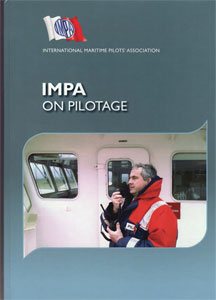IMPA on Pilotage
Various authors
Witherby Seamanship International, Edinburgh, Scotland 2014
256 pages
On long dark nights, when wheelhouse talk on the tugs or ships turns to plans for the future, the subject of entering the pilots often comes up. It is not just the good pay that attracts the tug captain on a 30-day rotation. The thought of being home, if not every day then a great deal more often than the regular mariner’s life allows, carries some real attractions. At the same time, most workboat captains understand all too well the challenges of working a tug or other offshore vessel in close to the beach, which is, of course, routine for a pilot.
For all those aspiring pilots, as well as other mariners who are interested in the challenges of piloting, there is now a book that tells it all. “IMPA on Pilotage” was put together by the International Maritime Pilots’ Association and published by Witherby Seamanship International of Edinburgh, Scotland. Each of the book’s chapters is written by pilots from various ports with specific expertise on the subject. The authors are all involved in pilotage in Europe and North America, including those passages that separate Europe from Asia, and North from South America.
A growing concern for pilots as well as masters has been the increased criminalization of responsibility in the event of maritime accidents. In the first chapter, Paul G. Kirchner, executive director and general counsel of the American Pilots’ Association, contributes a detailed review of the contemporary situation in the U.S. His general position is that criminal law is inappropriate when applied to vessel casualties as “it encourages those in the maritime industry to point fingers, engage in ‘spin,’ (and) play the blame game … In this respect, criminalization of maritime casualties is a primary contributor to the ‘blame culture’ that currently plagues the maritime industry” while harming the goal of preventing casualties.
Chapter 2, on conducting pilotage, includes sections written by both Panama and Kiel canal pilots as well as articles on the pilot’s passage plan, master-pilot exchange, standard marine navigational vocabulary and separate sections covering each of winter, river, deep-sea and straits pilotage. Capt. Bernard Cayer of the Lower St. Lawrence Pilots contributes a piece on under-keel clearance and the dynamics of “squat.” This latter topic is revisited in more specific detail in later chapters.
The third chapter examines some of the varied technology encountered by pilots in their work. In the course of a week’s work, a pilot may go from guiding a warship to a sailing vessel or even a self-propelled semi-submersible. The Livingstone brothers — Grant of the Long Beach port’s pilots and George of the San Francisco pilots — team up to write the sections on warships and unusual vessels. Capt. Michael A. Morris contributes a section titled “Interaction” in which he describes his work in the Houston Ship Canal, where the “Texas 3-Step” is employed when vessels meet and pass each other with as little as 100 feet of separation. This chapter includes a well-informed discussion on tug use by Capt. Henk Hensen, with excellent illustrations of various propulsion systems and ship handling approaches.
For obvious reasons, required pilotage skills can vary markedly with the geographical variations from port to port. The route to joining a pilotage can also vary. Chapter 4 covers aspects of requirements, training and certification. Clayton “Clay” Diamond, who has a Coast Guard background and is currently deputy director and associate general counsel of the American Pilots’ Association, presents a section on entry to U.S. pilotages. This chapter covers topics such as continuous professional development, mentor training, use of simulators, and manned models. The final section in this chapter is co-authored by Capt. Jorge J. Viso of the Tampa Bay pilots and details the history and importance of bridge resource management for pilots.
Fatigue management is given its own chapter and is presented by the Australian Capt. Peter Dann. A fatigue risk trajectory is illustrated to show how early attention, noting symptoms and maintaining data can prevent incidents.
Chapter 6 deals with the exciting and dangerous aspect of pilotage: transfers. The whole of this book is lavishly illustrated, but this chapter — with sections on pilot boat evolution and pilot vessel types — is particularly rewarding. The final section of the chapter, by Capt. Gary Lewin of the Columbia Bar Pilots, includes dramatic images and, more importantly, a detailed description of the care and planning behind the acceptance of helicopter use by the bar pilots. It indicates the cooperative nature of decision-making in most pilot groups. For shipping companies that may object to the cost of helicopters, Lewin writes, “The ability to be flexible at the boarding location (when using helicopters) allows the ships to maintain speed and enter the navigational channel from different course angles. This saves time and fuel for the ship. In our situation, we can generally save enough fuel during the inbound and outbound transfers to more than pay for the helicopter operation.”
“IMPA on Pilotage” is filled with many such nuggets of information that will answer the questions of potential and practicing pilots. George Livingstone said recently that there are about 50,000 vessels of over 10,000 gross tons worldwide, and these will have approximately 100,000 captains. Most of these ships will require a pilot at each end of their voyage. In the coming years, as the baby boom bubble passes through the ranks of the 6,000 or 7,000 North American pilots, there will be a steady demand for new people. For those contemplating the move, as well as for those in the pilotage, this book offers great insights to the profession.

